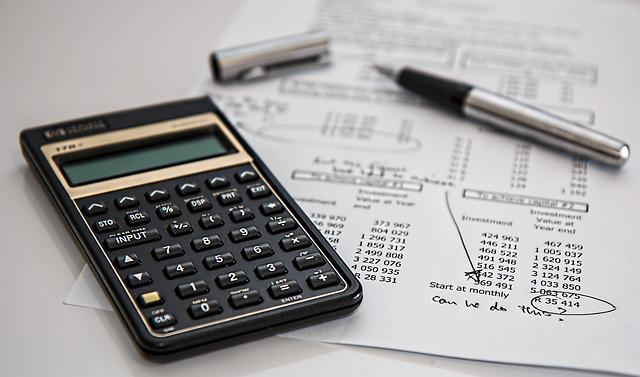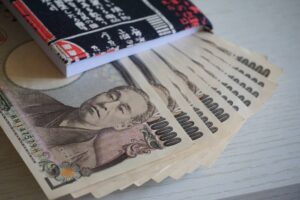Ahhh Japan. Scenic landscapes filled with mountains, rice fields, and shrines – or maybe crowded streets and bright lights are more your speed. Whatever your tastes, there’s a place for you. But it ain’t free!
The cost of living in Japan per month is around ¥160,000, which translates to $1,140 USD as of November 2022. This includes things like rent, food, and other spending money. However, as with any budget there are many personal factors that can bring that number up or down such as cars and rent.
The article below will dive into that and give a breakdown that will help you calculate your own monthly spending and where you could either save or splurge.
Average Rent in Japan

As with any country in the world, Japan’s rural areas tend to be cheaper to live in. This applies to accommodations more than anything else. For example, Okinawa’s cost of living will be much cheaper than Tokyo’s.
On average, you can expect to pay around ¥50,000 per month for an apartment, but what exactly does that get you?
In most cities, consider yourself lucky if that much money gets you a 1R apartment, which stands for “1 room.” In other words, a studio with showers and toilets typically on the opposite end of the apartment.
The nicer the area, the more expensive that type of apartment can get.
What you’ll find in lower population areas varies, but generally at that price range you’ll get a bigger kitchen/dining area and at least one room and hopefully a living room, known as a 1LDK.
If you’re trying to penny pinch, there are older apartment buildings that will drop down into the ¥30,000 range and sometimes even lower. Depending on the company you work for, you may also have the option of subsidized living. Oh, and most companies will also arrange things beforehand for you since people tend to head to Japan with little Japanese.
If you’re more of a city slicker hoping for a spot in places like Tokyo or Osaka, you should budget for at least ¥70,000.
Or, you could take a small step down in liveliness and look toward Kyoto’s lower rent.
Cost of Utilities in Japan

Each apartment is set up a little differently, but it’s safe to assume that you’ll need to pay for gas, electricity, water, and internet bills.
The first three bills can fluctuate based on your lifestyle, while internet will depend on how you choose to set yourself up.
Monthly Gas Bills
In some cases, you’ll use gas for water heating and cooking, with a bill that’s usually around ¥8,000. Someone who doesn’t cook can probably knock that down to ¥3,000, and there are even apartments that heat water with electricity, meaning that you could shut off your gas altogether. Ya know, if you’re not the fancy cooking type.
Monthly Electricity Bills
The biggest offender here is the air conditioner. In the summer many people crank it whenever they’re home, so electricity bills can often be around ¥10,000. Coastal locations can be quite warm in the winter, so you may hardly use your A/C at all. In that case you could be looking at winter bills of around ¥2,000.
Monthly Water Bills
This one isn’t as erratic and won’t change much from person-to-person unless you like to treat your bath like an en suite fountain installation. Oftentimes your landowner will ask for a flat rate. Other times, you’ll be charged based on usage. In any case, ¥4,000 is pretty common.
Monthly Internet Bills
Finally, we come to the topic of internet. Depending on your priorities, this may be the portion of your monthly budget where you’re not willing to cut corners. It also might be something you skip altogether if you’re using portable Wi-Fi or if internet is included with the building (like with Leo Palace rooms). However, for most people, monthly internet bills will be in the ¥5-6,000 range.

Photo by Maria Lin Kim
Grocery Bills in Japan
This one isn’t likely to change that much going from the city to small towns, either. The only way it might get cheaper is by bumming free produce from your part-time farmer co-workers. Farmer’s markets may also give the countryside a slight edge over cities.
With that said, grocery bills vary wildly in any country from person to person. Because where there’s a will, there’s a way to save a few bucks on your food bill.
For a mid-range example look to the fella writing this article. My monthly grocery tab usually hits the ¥40-50,000 range for a single person. That’s with quite a bit of time devoted to snacking.
As the author, I should also mention that I only eat out 2-3 times a month, so I might cook a little more than the average person.
Below is a list of some staple items from a local grocery store and their associated costs. Most fruits aren’t listed here since the prices vary pretty wildly based on quality (Japanese fruit can be insanely delicious) and the season.
| Product | Amount | Price (yen) |
|---|---|---|
| Milk | 1 liter | 200 |
| Chicken breast | per 100 g | 58 |
| Ground beef and pork mix | per 100 g | 140 |
| Mackerel fillet | 1 individual sized | 100 |
| Salmon fillet | 3 individual sized | 650 |
| Eggs | 10 | 250 |
| Japanese spinach | Large bag | 200 |
| Broccoli | 1 head | 300 |
| Medium-sized carrots | Bag of 3 | 200 |
| Tomato | 1 | 130 |
| Lemon | 1 | 140 |
| Diced tomatoes | 400 ml can | 100 |
| Butter | 200 g | 400 |
| White rice | 2 kg | 900 |
| Bento lunch/dinner | 1 | 400 |
Cost of Owning a Car in Japan
Everybody’s gotta eat, but not everyone has to drive, and that’s where the city-folk get to tip the scales back to normal. You should stay away from owning a car in bigger cities as some of the prices below may be more expensive and you’ll have to pay a hefty parking lot fee on top of that.
For those in the countryside, being able to rip around in a car makes life a lot more convenient. They’re often necessary for work, too.

Photo by melih karaahmet
If you do own one, there’s a chance that your company will pay the fees, but if you’re among those who are responsible for maintaining their own vehicle, the costs can stack up.
Many of those fees will come at the start of the year in one sum, but the table below will show monthly amounts for simplicity. The sum will also change based on the type of car – kei cars being cheaper in every category since they have smaller engines than the usual futsuujidoushas.
Here’s a rough guideline based on a used keijidousha:
| Type of fee | Explanation | Yearly and monthly total |
| Car registration | Needs to be paid every year, and often costs a little more in cities | ¥15,000/year¥1,250/month |
| Car insurance | Varies depending on factors like length of time driving, infractions, type of car, and type of license | First year: ¥80,000/year¥6,600/month |
| Car inspection | Mandatory, needing to be done every two years for older cars. The price depends on what kind of repairs they recommend | Minor repairs: ¥70,000/2 years¥3,000/month |
| Gas | Currently around ¥160/liter, so you can add up the fees based on how much you drive. A full keijidousha tank usually costs around ¥3,500, though | Filling up once every two weeks:¥7,000/month |
Yes, cars are expensive. And that’s without mentioning the cost of buying the car in the first place which can be ¥100,000 on the cheap end for a very old model with the car inspection already taken care of.
Since the price of train tickets in Japan is quite cheap and your employer will foot a lot of the bill anyway, you may be better off travelling by rail.
Cost of Going Out in Japan
That covers most of the necessities to this point, but what about the UNnecessary things? Gotta have fun, right??
A cheap dinner out like curry or ramen, for example, will cost something like ¥750-1,500.
Multi-course dinners with drinks typically cost ¥3-5,000.
There are plenty of other things you’ll want to do while living in Japan like splashing cash at arcades or bars, too.
There are also plenty of places to visit in Japan that can end up draining the bank account.
It’s tough to go into details on that, though, because some like to spend and some prefer saving.
Other Costs

Last comes some of the other things you may end up paying for each month in Japan. Some are optional, while others are mandatory.
Gym Memberships
If you’re someone who likes to stay in shape, this may fall under the ‘mandatory’ category. And fees will differ based on location and the state of the gym. Public gyms, for example, are often much cheaper, though less well equipped.
Private gyms usually cost around ¥6-7,000/month. Most gyms also offer single-visit prices and ticket packages that will run you roughly ¥700/visit.
Cell Phone Plan
If you’re a data hog who watches videos and downloads apps off Wi-Fi wherever they please, you’ll want a more expensive plan. These will usually run you somewhere in the neighborhood of ¥6,000/month.
If you’re okay with living off the data equivalent of food stamps each month — as many are — then you can get a 2-3 GB plan with cell service for ¥2,000/month.
Income Tax
Like most countries, Japan has many different tax brackets with the lowest being taxable income below ¥1,950,000 at 5%. The next bracket – which most English teachers will fall under – is from ¥1,950,000 to ¥3,300,000 at 10%. The Ministry of Finance has outlined every tax bracket in a detailed post.
Other Income Deductions
On top of income tax, your employer may deduct several other things from your monthly income for you. This may include the following:
- Health insurance
- Employment insurance
- Pension payments
- Residence tax (you won’t pay this in your first calendar year)
From the English teacher tax bracket mentioned above, you can expect to have something like 20% shaved off your monthly income with residence and income tax included.

Image by Steve Buissinne
Adding Up Your Cost of Living in Japan per Month
Not to sound like a broken record, but how much money you fork over each month depends on a lot of factors, not least important is whether you live in rural or urban Japan.
The rent number below is cheap as far as city apartments go, but if you include the monthly payments for a car, it basically balances out.
Here’s a general outline of what your monthly cost of living in Japan might look like:
- ¥50,000 for rent
- ¥25,000 for utilities
- ¥40,000 for groceries
- ¥17,850 for car
- ¥20,000 for fun (this is basically an arbitrary number, but not too far off for me)
- ¥6,000 for gym
- ¥3,000 for cell phone
So, the total here is ¥161,850, or roughly $1,150 USD.
On top of that, you can expect to wave goodbye to 20% of your taxable income if you’re making a typical Assistant Language Teacher (ALT) salary. Those range from ¥230,000/month to ¥330,000.
Sound grim? Read to the end.
Conclusion
The amount you spend in Japan each month can fluctuate wildly from person to person, and the numbers in this article are probably a little above average. When moving to another country, you should hope for the best and expect the worst, though.
If you spend enough time looking for a cheap apartment, you’ll probably find one. And depending on who you work for, your car costs may be next to zero.
As for the rest, there are plenty of areas to trim the fat from depending on how badly you want to save money.
However you decide to budget, you’re going to have a great time!
A monthly budget is one thing, but you need to spend a little to get into Japan in the first place. Take a look at our article on the cost of moving to Japan to prepare yourself.




